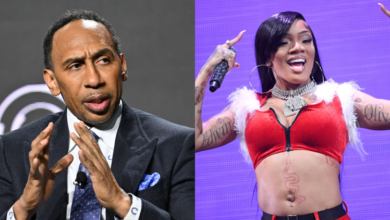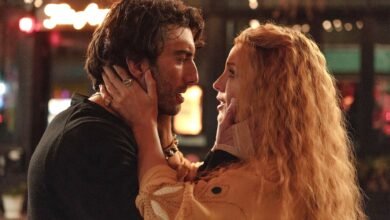Bridgerton Walked So My Lady Jane Could Trot

Spoilers for My Lady Jane (mainly its first two episodes) ahead—gallop along at your own risk.
After her nine-day stint as England’s teenage Tudor queen, Lady Jane Grey was beheaded and banished to the footnotes of her era. “History remembers her as the ultimate damsel in distress,” as the narrator of Prime Video’s My Lady Jane puts it. Then: “Fuck that. What if history were different?”
The narrator (Oliver Chris) then recaps the events that led to Jane’s short-lived reign. A great-niece of Henry VIII (“Treated his wives like Kleenex—one blow and you’re out”), Jane is named heir to the throne (“bloody shocker”) after her cousin Edward VI dies. She is an “intellectual rebel, a bit of a pain in the ass, and a political pawn for her ambitious noble family” who lasts little more than a week on the throne before “off with her head.” While Lady Jane’s story has been told before—she’s the subject of Paul Delaroche’s famous portrait and a 1986 film starring Helena Bonham Carter—this is the first full-blooded anachronistic reimagining of the tragic heroine.
Historical fan fiction with a contemporary tilt has been all the rage as of late: see Hulu’s The Great; AppleTV’s The Buccaneers and Dickinson; Broadway’s Six; and—most recently—Netflix’s Bridgerton, which concluded its record-breaking third season on June 13. One fortnight later, another edgy eight-episode period romance swept in to fill the void.
On the surface, Bridgerton and My Lady Jane share a lot of DNA, from modernized soundtracks (Taylor Swift and Billie Eilish are traded for Kate Nash and Tegan and Sara) to bodice-ripping love scenes. But the shows feel vastly different in tone, a divide best encapsulated by a viewer who writes that My Lady Jane is “like if they wrote Bridgerton on ketamine, and I mean that in a good way.” (Prime Video, if you’re here, the phrase “Bridgerton on ketamine” should be to this show’s marketing what “Every Parent’s Nightmare” was to Gossip Girl.)
Based on the bestselling novel by Brodi Ashton, Cynthia Hand, and Jodi Meadows, the series was created by Gemma Burgess, who serves as co-showrunner with The Boys’ Meredith Glynn. Our spirited Jane Grey (Emily Bader) is a staunchly independent herbalist—she cures her best friend’s venereal disease via homemade salve in the show’s opening scene—who is afflicted by an arranged marriage. Jane must wed the rakish Guildford Dudley (Edward Bluemel) to save her family from destitution. Both parties enter into the union kicking and screaming, their palpable physical attraction to each other be damned.
But mere hours into their marriage of convenience, Jane makes a discovery that throws the rest of her life—and this bonkers series—into utter chaos. Jane’s new husband Guildford is, stay with me here, a horse.
To be clear: This is not a Dr. Dillamond in Wicked or Mr. Tumnus in Narnia situation. Guildford is not half man, half beast: He can turn into a fully neighing, trotting, stable-sleeping steed. It’s blatantly absurd, but he’s not this universe’s only shape-shifter. Just 10 minutes into the show’s first episode, Jane’s lady’s maid and innermost confidant Susanna (Máiréad Tyers)—yep, the same one recovering from the clap—morphs from woman to hawk. (No, not that one.)
“Did I mention that, in this world, some people can transform themselves into an animal?” the show’s narrator offers. We learn that both Susanna and Guildford are Ethians: humans who can take animal form and are often hunted by pure-blooded people known as Verities. If you hadn’t figured it out yet, this is meant to be a metaphor for the Protestant-Catholic conflict in Tudor England. And in case you were wondering, according to the series, Anne Boleyn was Ethian—“An animal both in and out of the sack,” Guildford’s father (Rob Brydon) quips.
Henry VIII has largely exiled the Ethians from polite society and made it illegal for regular folks to fraternize with the group, meaning they often have to scrounge and steal in order to survive. It’s unclear how, exactly, an Ethian is detected because they can shape-shift at their own whim—a man takes to his grizzly bear form during a barside brawl; a woman shifts out of her existence as a lap dog named Petunia to alert King Edward (Jordan Peters) that he’s being poisoned. But that same courtesy doesn’t extend to Guildford, who has never had control over when he begins to—sorry—horse around.
The series, which is primarily directed by Jamie Babbit, does quick, if a bit confusing, work explaining what Guildford’s condition means. Ethianism skips generations but is typically triggered in puberty during a moment of high emotion. For Guildford, that was on the day of his mother’s murder. Ethians can’t choose which animals they morph into, which is nasty luck for the man turned bug who gets squashed under the boot of the sinister Lord Seymour (Dominic Cooper). With no authority on his own shape-shifting abilities, Guildford is cursed to be horse by day, man by night. While the sun is out, Jane can use her husband as a means of transportation and after it sets, he gets taken for a different kind of ride. Which they do in a literal stable, by the way.
They say that you can lead a horse to water, but can’t make him drink. Yet My Lady Jane makes it alarmingly easy to buy into this ridiculous premise. Like Jane, who, after vowing to cure Guildford, turns her attention to banning division laws as England’s newly anointed queen, viewers have taken the twist in stride. “The marketing for My Lady Jane failed so hard because they assumed their audience would be like ‘wait, he turns into a HORSE?! No, I don’t want to watch that,’ writes one fan, “when the reality is THE OPPOSITE.” As it turns out, sometimes you just want to watch a hot man morph into a horse and contend with whatever strange feelings may stem from that at a later date.
Like The Princess Bride, Bridgerton, and 1996’s Romeo + Juliet—on which this show’s poster is modeled—hell, even Shrek, My Lady Jane feeds our desire to revisit a restrictive historical period while ignoring the parts that made actually living through said time feel icky. And there are a lot of tawdry delights to be found in My Lady Jane, brought to life largely through its kooky ensemble cast. Jim Broadbent plays an alcoholic duke with grotesque giddiness. Kate O’Flynn’s vicious Lady Mary declares that she detests bathing and has the blackened feet to prove it. And Jane’s mother, Lady Grey (Anna Chancellor) is a proto Real Housewife thanks to a May-December fling with Guildford’s brother (Henry Ashton). He calls his lover “Mommykins,” and she tells her youngest daughter (Robyn Betteridge) that “Mummy’s best skill is fellatio.”
By season’s end, Jane and Guildford have narrowly escaped execution for treason. (Things ended on a less rosy note in real life, with their joint beheading on February 12, 1554.) “True love really can conquer all—ish,” says the series’ narrator, suggesting that there is more story to tell, should My Lady Jane mount a very deserved second season. Perhaps the show will borrow from untapped aspects of the novel—Jane’s discovery that she’s an Ethian who transforms into a ferret is right there. I’m also yearning for the whole my-husband-is-a-horse thing to be deployed more in Jane and Guildord’s marital spats. In fact, the next season’s opening lines have already been written: “I asked him to change back to talk to me, but he won’t,” Jane says in the book. “It’s disrespectful to remain a horse in the bedchamber, I should think.” Prime Video powers that be, consider this your call to pony up.
-
The Dark Origins of the True-Crime Frenzy at CrimeCon




